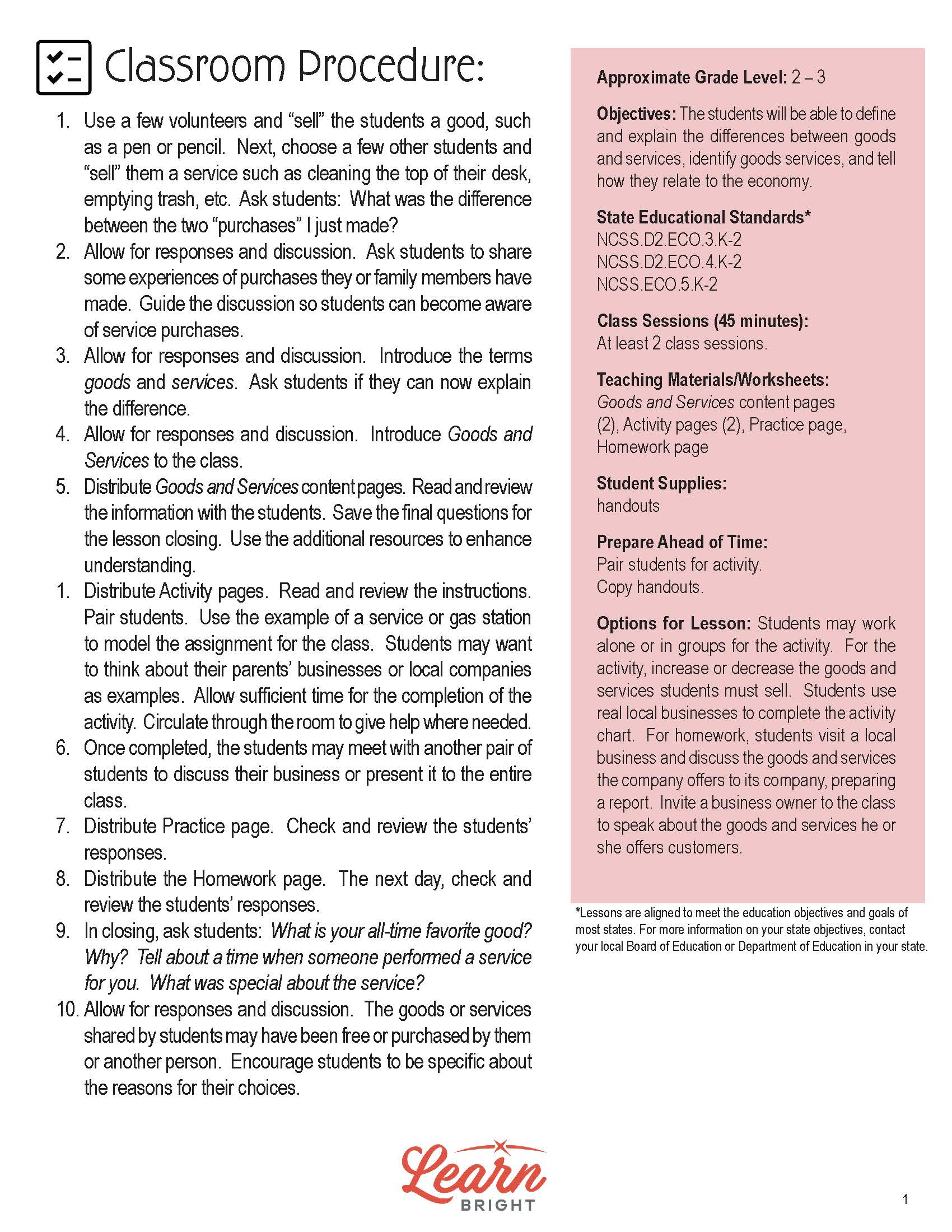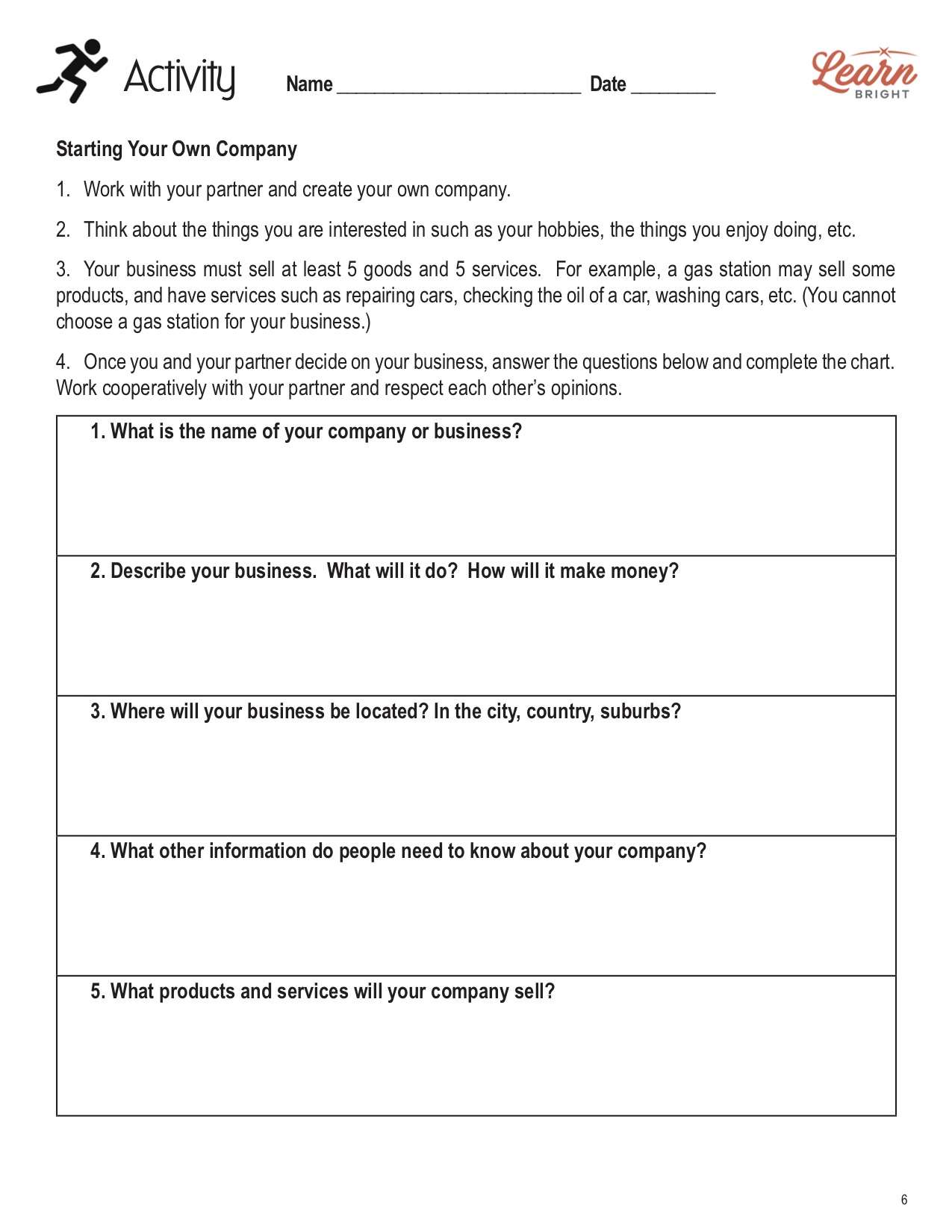Description
What our Goods and Services lesson plan includes
Lesson Objectives and Overview: Goods and Services teaches students about these specific aspects as they relate to economics. Students will be able to define both terms and explain the differences between the two. They will be able to identify both and tell how they relate to the economy. This lesson is for students in 2nd grade and 3rd grade.
Classroom Procedure
Every lesson plan provides you with a classroom procedure page that outlines a step-by-step guide to follow. You do not have to follow the guide exactly. The guide helps you organize the lesson and details when to hand out worksheets. It also lists information in the red box that you might find useful. You will find the lesson objectives, state standards, and number of class sessions the lesson should take to complete in this area. In addition, it describes the supplies you will need as well as what and how you need to prepare beforehand. The only supplies you will need are the handouts.
Options for Lesson
Included with this lesson is an “Options for Lesson” section that lists a number of suggestions for activities to add to the lesson or substitutions for the ones already in the lesson. If you’d like to adjust the lesson activity, you could increase or decrease the number of goods or services students have to sell. Another option is to have students use real local businesses for the activity. For an additional homework assignment, you could have students visit a local business and discuss the goods and services that the business offers. Finally, you can invite a business owner to the class to talk about the goods or services that they provide their customers.
Teacher Notes
The teacher notes page includes a paragraph with additional guidelines and things to think about as you begin to plan your lesson. This page also includes lines that you can use to add your own notes as you’re preparing for this lesson.
GOODS AND SERVICES LESSON PLAN CONTENT PAGES
Goods and Services
The Goods and Services lesson plan includes three pages of content. The lesson begins by explaining that everyone uses goods and services every day. The food you eat, the clothes you wear, the chairs you sit in, the TV you watch, the pencil you write with, and more are all items that we call goods. We can see and touch goods.
We cannot see and touch services, on the other hand. They are activities that others perform to satisfy a need. When a plumber works on the pipes in your house, they’re performing a service. When someone delivers a pizza to your house, they’re also performing a service.
We use goods and services every day to meet our wants and needs. Needs are things that we need to live, such as food, water, shelter, and clothes. Wants are things that are not necessary, such as books, games, toys, and more.
Economies are systems that determine how we use money and resources within a country or region. They include the goods produced and services performed. We call people, like family, friends, and neighbors consumers. They buy goods and services using money.
Producers are people who sell goods or services. They make the goods or perform the services. Some goods and services are free. For example, if you wanted some seashells, you could go to the beach and find some for free. However, if you don’t live near the beach, you would have to go to a store and buy some instead.
We’ve based our economy on producers making goods and providing services and consumers buying those goods and services.
Differences Between Goods and Services
Goods and services are both important and both satisfy human needs and wants.
Goods are tangible, which means we can touch and see them. We usually produce them first and consume them later, sometimes with a large gap of time in between when we produce them and when we consume them. A company might manufacture a TV days, weeks, months, or years before a consumer buys and uses it. We can store goods and use them later. For example, your family might buy many rolls of paper towels at once and store them until you need them. You can move goods from place to place or transfer them from person to person. For example, you can buy a TV and give it to someone else as a gift or sell them to a neighbor.
Services are non-tangible, which means we cannot touch or see them. If you go see a doctor, that’s a service. The doctor provides a service and does not sell a product. We produce services which we usually consume immediately. We can’t store services until later. For example, you can’t save a doctor’s service for later. Additionally, we can’t transfer a service to someone else. Services are unique to the consumer.
People can produce goods and services in different ways. Some goods are free and some need to be purchased. Economic goods are goods that we purchase, like fruits and vegetables. However, people can also grow their own fruits and vegetables for free.
Some services are also free. If you’re looking for a job, you might go to the library and use the computers for free to look for a job. In this case, you’re receiving the services of the library for free. While this service is free for you, the government pays to run the library using taxes.
Sometimes, we deliver and consume goods and services at the same time. If you’re a mechanic, you’re selling your service, but you may also sell goods like brakes and oil for cars. The car owner consume both services and goods.
The lesson then lists various things and asks students to determine whether they are goods or services. For these examples, bread and cereal, buying a game for $3, and a lunch tray at school are goods. They are tangible. Transportation on a bus, a friend cleaning your room, and a haircut are services. These services are performed by a person and are unique to the consumer.
GOODS AND SERVICES LESSON PLAN WORKSHEETS
The Goods and Services lesson plan includes three worksheets: an activity worksheet, a practice worksheet, and a homework assignment. You can refer to the guide on the classroom procedure page to determine when to hand out each worksheet.
START YOUR OWN COMPANY ACTIVITY
Students will work with a partner on the activity. (You may choose to have them work alone or in groups.) They will work together to create their own company. They will discuss the things that interest them and come up with five goods and services that relate to their interests. Once they decide on what their business will be, they will answer five questions about it. On the second page, they will fill out the charts that list the five goods and five services they will sell and provide. They must also list a reason for each one.
Students can work either alone or in groups.
GOODS AND SERVICES PRACTICE WORKSHEET
For the practice worksheet, students must read through 20 different statements. They will have to determine whether the statement represents a good (G) or a service (S).
FILL IN THE BLANKS HOMEWORK ASSIGNMENT
The homework assignment divides into two sections. The first section contains 10 sentences. There are 10 words in a word bank at the top of the page. Students will fill in the blank in each sentence with the correct term. For the second section, students will read a paragraph and answer two questions that relate to what they read.









